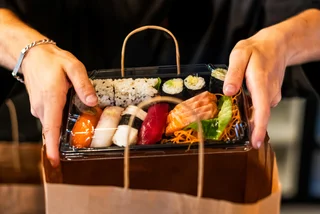The Czech love of mushrooming is well-known. Head to the woods and you’ll see whole families involved in the search. Sometimes you don’t even have to go that far, as you’ll see people coming home on the trains with a basket, maybe two, laden with mushrooms.
So where do you start?
Where to start
Many of the edible varieties of mushroom grow wherever there are trees as they live in a symbiotic relationship with the roots. Other species can be found in fields, and sometimes even poking out of lawns. Basically, where there is ample vegetation you’ll find some variety of fungus. However, just be sure not to pick mushrooms in national nature reserves. It’s possible to go hunting in limited areas of national parks and protected areas (the latter designated by the abbreviation CHKO), but consult the visitor rules.
When
You can find mushrooms from mid May until early November. As long as there is enough water and warmth they will grow. Common wisdom has it that a warm day after some rain is a good day to look, whereas day after a very cold night is unlikely to turn up much. However, even an overcast day can be successful.
Some people also claim that mushrooms grow with the waxing moon. However, this theory has not been conclusively proven. Nor is necessarily true that mushrooms follow our daily cycle and rise early. The morning is simply the best time to go because those who seek them like a head start.
Common Edible Varieties
Edible bolete
Boletus edulis
Time of Year: July to November
The Czech name for this is smrkový hřib or ‘spruce bolete’ as they are often found in spruce forests, though they can be found living with other trees. The other Czech name for this mushroom is pravák, meaning ‘the right one’ – as in the right one to pick. Its appearance can vary depending on the size. Smaller specimens will have their caps quite tight to a rather bulbous stipe (stem). Larger specimens will have a separate cap showing the yellow sponge containing the spores. These are very popular edible mushrooms, which is no doubt why the scientific name is simply boletus edulis – edible bolete.

Edible Bolete
Bay Bolete
Boletus badius
Time of Year: June to November
Because of its long growing season, this is quite a common mushroom. Not as good as the edible bolete, but still a good addition to a soup. The cap is dark brown and distinct from the stipe which is yellow-brown.

Bay Bolete
Red Cracked Bolete
Boletus chrysenteron
Time of Year: June to November
This mushroom is best picked when it is firm and young. The older become soft and unusable quickly. Older ones are distinguished by their size and that their caps begin to crack. They are also very soft to touch.

Red Cracked Boletus
Shaggy Bolete
Leccinum scabrum
Time of Year: July to October
This mushroom is found under birch trees, with which it forms a symbiotic relationship. Even its stipe, which is white with black scales, sort of resembles a birch. The flesh goes a very dark purple (almost black) when cut. This mushroom is exceptionally good eating and is recommended for pickling.

Shaggy Bolete
Larch bolete
Suillus grevillei
Time of year: June to November
Another mushroom with a specific symbiotic relationship, this bright orange mushroom is surprising edible. The mushroom does have a slimy membrane which should be peeled off before cooking.

Larch Bolete
Blue Staining Boletes
A number of species in the boletus genus stain blue when cut. Some, like the lurid bolete, are edible when cooked. However, others such as the devil’s bolete and the red pored bolete are poisonous. If you are not experienced I’d avoid the blue-staining ones.

Lurid Bolete

Lurid Bolete Cut
How to identify poisonous mushrooms
Some general guidelines about identifying or preparing poisonous mushrooms exist. You may hear some of the following:
- Insects and other critters don’t eat poisonous mushrooms
- Poisonous mushrooms taste bad
- Poisonous mushrooms are brightly colored
- Poisonous mushrooms have a pointed cap.
Based on the testimony of experienced mushroom gatherers not one of these statements is consistently true for all poisonous mushrooms. None is a reliable way to identify a poisonous mushroom.
The best way to avoid poisoning is:
- learn the poisonous mushrooms
- avoid anything you don’t recognize
Common Poisonous or Inedible Mushrooms
Bitter Bolete
Tylopilus felleus
Time of Year: July to November
At first glance, this inedible mushroom looks like the edible varieties. Some tell-tale differences are that the color extends even more over the body, and that the sponge is white and spores pink (though they can go brown on older specimens). The flesh is very bitter, so if in doubt sampling a tiny portion should identify it straight away.

Bitter Bolete
Velvet Roll-Rim
Tapinella atrotomentosa
Time of Year: July to October
Like the two edible boletes, this mushroom has a velvety cap. There the similarities end. Turning the mushroom over will reveal yellow gills. The mushroom is not poisonous but it is inedible.

Velvet Roll-Rim
Amanitas
Amanitas include a wide range of mushrooms from the edible to the highly toxic, including the well-known fly agaric. For this reason, it is best for inexperienced collectors to avoid them altogether, because some edible species are easily confused with their incredibly poisonous cousins.
Amanitas are often distinguished by gills under the cap and white crusty scales on the top of the cap. The stem is usually very thin. For safety’s sake, avoid mushrooms such as the ones below unless you really know your fungi.

Amanita pantherina (false blusher)

Amanita phalloides (death cap)

Amanita muscaria(fly agaric)
Disclaimer: The information provided in this article is for informational purposes only. You should always consult the mushrooms you pick with an expert in the field or someone who has extensive experience picking them. Expats.cz is not responsible for any consequences caused by the misuse or accidental consumption of poisonous mushrooms.
Collecting the mushrooms
Remember, the part we call the mushroom is just the fruiting body of a much larger organism. That means when taking the visible surface part you don’t want to damage the organism underneath, so pluck carefully or cut with a knife, but don’t dig into the ground.
Also, it’s customary to gently scrape any dirt from the stem and cap. Then you want to slice into the stem to see if the mushroom has been eaten by larvae.
You can keep slicing through the stem until you find no more holes. Sometimes you might be left only with the cap.
Preparation
After a successful day of collecting, you’ll probably want to sample some of your mushrooms fresh and preserve the rest.
Some popular ways to prepare mushrooms are to add them to soup, especially potato soup, to bread and fry the caps, or the make smaženice. This dish is when a variety of mushrooms are cut into small pieces and cooked with onions and cumin (ground, crushed or whole). At the end, eggs are mixed in. If you want to try, here is a recipe from Apetit magazine (in Czech).
Drying is a popular and practical way to keep the excess. Thinly slice the mushrooms and place on a thin drying screen then leave in the sun. Depending on the temperature it can take one to two days to dry a screen’s worth. By the way, as the pieces dry they shrink, so you can add more to the screen.
If you want to keep your mushrooms in whole pieces, lightly fry them on solid cooking oil or lard. Then freeze them. The pieces keep their shape and flavor and are great for a winter soup or mushroom sauce.
Mushrooms are also suitable for pickling. This recipe from Cooks.com is straightforward enough. I also like to add some onion slices to mine. When you take the mushrooms out, the brine might seem a little slimy. This is normal.
Have you had any mushroom-gathering adventures?












 Reading time: 6 minutes
Reading time: 6 minutes 


























